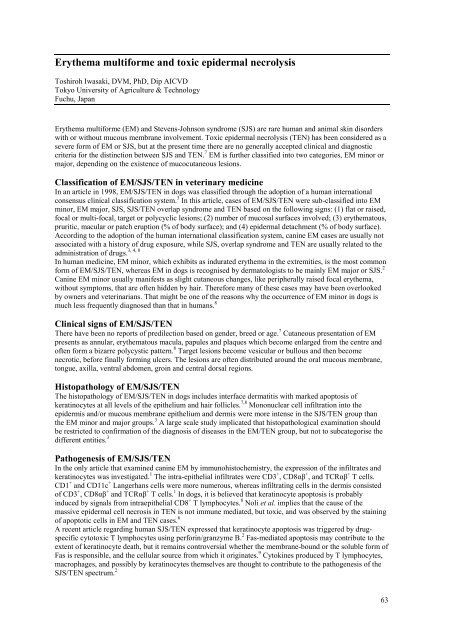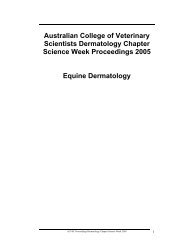Erythema multiforme and toxic epidermal necrolysis
Erythema multiforme and toxic epidermal necrolysis
Erythema multiforme and toxic epidermal necrolysis
Create successful ePaper yourself
Turn your PDF publications into a flip-book with our unique Google optimized e-Paper software.
<strong>Erythema</strong> <strong>multiforme</strong> <strong>and</strong> <strong>toxic</strong> <strong>epidermal</strong> <strong>necrolysis</strong><br />
Toshiroh Iwasaki, DVM, PhD, Dip AICVD<br />
Tokyo University of Agriculture & Technology<br />
Fuchu, Japan<br />
<strong>Erythema</strong> <strong>multiforme</strong> (EM) <strong>and</strong> Stevens-Johnson syndrome (SJS) are rare human <strong>and</strong> animal skin disorders<br />
with or without mucous membrane involvement. Toxic <strong>epidermal</strong> <strong>necrolysis</strong> (TEN) has been considered as a<br />
severe form of EM or SJS, but at the present time there are no generally accepted clinical <strong>and</strong> diagnostic<br />
criteria for the distinction between SJS <strong>and</strong> TEN. 7 EM is further classified into two categories, EM minor or<br />
major, depending on the existence of mucocutaneous lesions.<br />
Classification of EM/SJS/TEN in veterinary medicine<br />
In an article in 1998, EM/SJS/TEN in dogs was classified through the adoption of a human international<br />
consensus clinical classification system. 3 In this article, cases of EM/SJS/TEN were sub-classified into EM<br />
minor, EM major, SJS, SJS/TEN overlap syndrome <strong>and</strong> TEN based on the following signs: (1) flat or raised,<br />
focal or multi-focal, target or polycyclic lesions; (2) number of mucosal surfaces involved; (3) erythematous,<br />
pruritic, macular or patch eruption (% of body surface); <strong>and</strong> (4) <strong>epidermal</strong> detachment (% of body surface).<br />
According to the adoption of the human international classification system, canine EM cases are usually not<br />
associated with a history of drug exposure, while SJS, overlap syndrome <strong>and</strong> TEN are usually related to the<br />
3, 4, 8<br />
administration of drugs.<br />
In human medicine, EM minor, which exhibits as indurated erythema in the extremities, is the most common<br />
form of EM/SJS/TEN, whereas EM in dogs is recognised by dermatologists to be mainly EM major or SJS. 2<br />
Canine EM minor usually manifests as slight cutaneous changes, like peripherally raised focal erythema,<br />
without symptoms, that are often hidden by hair. Therefore many of these cases may have been overlooked<br />
by owners <strong>and</strong> veterinarians. That might be one of the reasons why the occurrence of EM minor in dogs is<br />
much less frequently diagnosed than that in humans. 8<br />
Clinical signs of EM/SJS/TEN<br />
There have been no reports of predilection based on gender, breed or age. 7 Cutaneous presentation of EM<br />
presents as annular, erythematous macula, papules <strong>and</strong> plaques which become enlarged from the centre <strong>and</strong><br />
often form a bizarre polycystic pattern. 8 Target lesions become vesicular or bullous <strong>and</strong> then become<br />
necrotic, before finally forming ulcers. The lesions are often distributed around the oral mucous membrane,<br />
tongue, axilla, ventral abdomen, groin <strong>and</strong> central dorsal regions.<br />
Histopathology of EM/SJS/TEN<br />
The histopathology of EM/SJS/TEN in dogs includes interface dermatitis with marked apoptosis of<br />
keratinocytes at all levels of the epithelium <strong>and</strong> hair follicles. 7,8 Mononuclear cell infiltration into the<br />
epidermis <strong>and</strong>/or mucous membrane epithelium <strong>and</strong> dermis were more intense in the SJS/TEN group than<br />
the EM minor <strong>and</strong> major groups. 3 A large scale study implicated that histopathological examination should<br />
be restricted to confirmation of the diagnosis of diseases in the EM/TEN group, but not to subcategorise the<br />
different entities. 3<br />
Pathogenesis of EM/SJS/TEN<br />
In the only article that examined canine EM by immunohistochemistry, the expression of the infiltrates <strong>and</strong><br />
keratinocytes was investigated. 1 The intra-epithelial infiltrates were CD3 + , CD8αβ + , <strong>and</strong> TCRαβ + T cells.<br />
CD1 + <strong>and</strong> CD11c + Langerhans cells were more numerous, whereas infiltrating cells in the dermis consisted<br />
of CD3 + , CD8αβ + <strong>and</strong> TCRαβ + T cells. 1 In dogs, it is believed that keratinocyte apoptosis is probably<br />
induced by signals from intraepithelial CD8 + T lymphocytes. 8 Noli et al. implies that the cause of the<br />
massive <strong>epidermal</strong> cell necrosis in TEN is not immune mediated, but <strong>toxic</strong>, <strong>and</strong> was observed by the staining<br />
of apoptotic cells in EM <strong>and</strong> TEN cases. 6<br />
A recent article regarding human SJS/TEN expressed that keratinocyte apoptosis was triggered by drugspecific<br />
cyto<strong>toxic</strong> T lymphocytes using perforin/granzyme B. 2 Fas-mediated apoptosis may contribute to the<br />
extent of keratinocyte death, but it remains controversial whether the membrane-bound or the soluble form of<br />
Fas is responsible, <strong>and</strong> the cellular source from which it originates. 9 Cytokines produced by T lymphocytes,<br />
macrophages, <strong>and</strong> possibly by keratinocytes themselves are thought to contribute to the pathogenesis of the<br />
SJS/TEN spectrum. 2<br />
63
EM/SJS/TEN therapy<br />
The most important factor in the therapy of EM/SJS/TEN is investigation <strong>and</strong> elimination of the triggering<br />
factors. 5, 8 When this is accomplished, the symptoms are usually resolved within 1–2 weeks. 8 In idiopathic<br />
cases of EM/SJS/TEN, a large dose of glucocorticoids with azathioprine <strong>and</strong>/or cyclosporine A may improve<br />
clinical signs. However, in human medicine, the use of glucocorticoids for treatment of EM/SJS/TEN has<br />
been controversial as their use may elicit systemic infection. 2, 9 The use of human immunoglobulin by<br />
intravenous injection for the treatment of canine SJS/TEN is thought to be beneficial for the treatment of the<br />
condition. 5<br />
References<br />
1. Affolter VK, Moore PF, S<strong>and</strong>maier BM. Immunohistochemical characterization of canine acute graft-versus-host<br />
disease <strong>and</strong> erythema <strong>multiforme</strong>. Advances in Veterinary Dermatology 1998; 3:103-115<br />
2. Borchers AT, Lee JL, Naguwa SM, Cheema GS, Gershwin E. Stevens-Johnson syndrome <strong>and</strong> <strong>toxic</strong> <strong>epidermal</strong><br />
<strong>necrolysis</strong>. Autoimmunity Reviews. 2008; 7: 598-605<br />
3. Hinn AC, Olivry T, Luther PB, Cannon AG, Yager JA. <strong>Erythema</strong> <strong>multiforme</strong>, Stevens-Johnson syndrome, <strong>and</strong> <strong>toxic</strong><br />
<strong>epidermal</strong> <strong>necrolysis</strong> in the dog; Clinical presentation, drug exposure, <strong>and</strong> histopathologic correlations. Journal of<br />
Veterinary Allergy <strong>and</strong> Clinical Immunology 1998; 6:13-<br />
4. Mason K, Fadok V. Cutaneous drug eruption with <strong>epidermal</strong> necrosis: A discussion of pathophysiologic <strong>and</strong><br />
comparative aspects. Clinics in Dermatology 1994; 12: 525-528<br />
5. Noli C, von Tscharner C, Suter M. Apoptosis in selected skin diseases. Veterinary Dermatology 1998; 9: 221-229<br />
6. Nuttal TJ, Malham T. Successful intravenous human immunoglobulin treatment of drug-induced Stevens-Johnson<br />
syndrome in a dog. Journal of Small Animal Dermatology 2004; 45: 357-361<br />
7. Scott DW, Miller W, Griffin C. <strong>Erythema</strong> <strong>multiforme</strong>. In: Small Animal Dermatology 6 th ed. Philadelphia Saunders,<br />
2001: 732-742<br />
8. Scott DW, Miller W. <strong>Erythema</strong> <strong>multiforme</strong> in dogs <strong>and</strong> cats: literature review <strong>and</strong> case material from the Cornell<br />
University College of Veterinary Medicine (1988-1996), Veterinary Dermatology 1999; 10: 297-309<br />
9. Sontheimer RD. Lichenoid tissue reaction/interface dermatitis: Clinical <strong>and</strong> histological perspectives. Journal of<br />
Investigative Dermatology 2009; 129: 1088-1099<br />
64
















